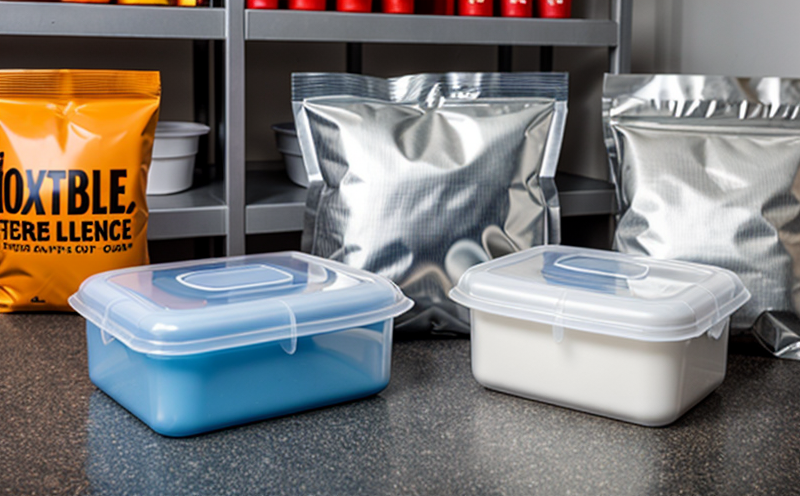ASTM D3354-12 Adhesion of Laminates
The ASTM D3354-12 standard test method is designed to evaluate the cohesive strength and adhesion between layers in flexible packaging materials. This testing method is critical for ensuring that multi-layer structures used in food, pharmaceutical, and industrial packaging maintain their integrity under various environmental conditions.
This method is particularly important because it assesses how well different layers of a laminate hold together during stress or potential separation. The test is performed by peeling the specimen at a specified speed to determine the cohesive strength. Understanding the adhesion properties helps in optimizing material selection and processing parameters, which directly impacts the product's performance and shelf life.
Flexible packaging materials often consist of multiple layers of different materials such as polyethylene (PE), polyester (PET), or aluminum foil. The adhesive used to bond these layers can vary widely depending on the intended application. For instance, in food packaging, a barrier layer might be essential to prevent oxygen and moisture from penetrating into the package.
The ASTM D3354-12 test is not just about measuring adhesion; it also provides insights into how different environmental factors such as temperature, humidity, and time affect the integrity of the laminate. This information is crucial for quality managers and compliance officers who need to ensure that packaging meets regulatory standards.
For R&D engineers, this test can be used to optimize material combinations and improve product performance. By understanding how different layers interact, they can design packages that are more resilient to stress or potential separation. For procurement teams, the results of this test help in selecting suppliers who provide materials with consistent adhesion properties.
The test is performed on a specific type of sample, which typically includes multiple layers of packaging material bonded together with an adhesive layer. The specimen is cut into strips that are then subjected to the peel test at a predetermined rate. The force required to separate the layers provides valuable data about the cohesive strength and adhesion properties.
The ASTM D3354-12 method has been widely adopted in industries where flexible packaging plays a critical role, such as food, pharmaceuticals, and electronics. By ensuring that the materials used are reliable and robust, this test helps to prevent potential issues related to package integrity, which can lead to product spoilage or contamination.
The results of this test can also be used in conjunction with other mechanical tests to provide a comprehensive understanding of the properties of flexible packaging materials. For instance, tensile strength and elongation at break are often tested alongside adhesion strength to give a complete picture of how a material behaves under stress.
Applied Standards
- ASTM D3354-12: Standard Test Method for Peel Adhesion of Laminates Containing Thermoplastic Coatings or Films
The ASTM D3354-12 standard is one of several standards used in the packaging industry. It provides a specific protocol for testing the peel adhesion strength of laminates, which are multi-layered materials commonly found in flexible packaging.
Other relevant standards include:
- ASTM D892-15: Standard Test Method for Determining the Density and Specific Gravity of Plastics
- DIN 55403: Packaging – Requirements, Testing Methods and Evaluation Criteria for Flexible Packaging
- EN 12677: Packaging – Terminology
While these standards cover various aspects of flexible packaging testing, ASTM D3354-12 focuses specifically on the peel adhesion strength. This ensures that quality managers and compliance officers have a clear reference for ensuring that their materials meet industry standards.
Scope and Methodology
| Step | Action | Description |
|---|---|---|
| 1 | Cut specimen | Cut the laminate into a strip-shaped specimen of specified dimensions. |
| 2 | Prepare adhesive | Ensure that the adhesive used is compatible with the materials being tested. |
| 3 | Apply adhesive | Apply a specified amount of adhesive to one side of the specimen. |
| 4 | Cure | Cure the adhesive according to the manufacturer's instructions. |
| 5 | Test setup | Position the specimen on a fixture that allows for controlled peeling. |
| 6 | Pull apart | Peel the layers at a specified speed and record the force required to separate them. |
Quality and Reliability Assurance
- Regular calibration of test equipment ensures accurate results.
- Use of certified reference materials to validate the testing process.
- Detailed documentation of all test procedures and conditions for reproducibility.
Quality managers rely on consistent and reliable test methods to ensure that their packaging materials meet strict quality standards. The ASTM D3354-12 peel adhesion test is one such method that provides valuable insights into the integrity of multi-layered packaging materials.
The use of certified reference materials helps in validating the accuracy of the testing process, ensuring that the results are consistent and reliable. Detailed documentation of all test procedures and conditions ensures that the tests can be reproduced accurately, which is essential for compliance with industry standards and regulations.





